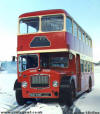Special Features Focus on : Winter
Contributed by Douglas G MacDonald, December 2002
In the bleak midwinter, not so long ago!
It may be merely a side-effect of retrospect, but the winters of yesteryear are recalled as being, well, simply more wintry than today’s fourth season! From the mid-fifties and right through the sixties, there always appeared to be a proliferation of frost, fog, ice and snow, prevailing mostly in a four-month spell from November to February. Given that weather forecasting was not as accurate and that road-clearing methods were not as sophisticated, public transport operators by and large coped well with the vagaries of the Scottish winter. Central SMT’s track record was respectable, taking into account a whole variety of factors.
Admittedly, comforts for passengers during this era were a touch spartan - poor/no heating, open platforms - but remember, the crews suffered this and more. These were the days of exposed radiators, crash/manual gearboxes, no power steering, plus less effective anti-freeze and de-icing agents. Consider, too, the territories covered by Central - the remote areas of South Lanarkshire, East Kilbride, Dunbartonshire - and the range of services from local to cross-county and inter-urban. From memory, it was only in extreme conditions that buses were taken off the road. I seem to recollect that on numerous occasions dense and freezing fog was as big a hazard as ice. In the industrial belts, this could be smog-like.
 | One of the 1949 batch of Leyland PD1s, L288 is pictured on the 205 (Hamilton – Eaglesham Direct), a service acquired with the Chieftain business in 1961. The contemporary timetable shows a journey time of 45 minutes, but this must have been far exceeded in conditions like those in the picture. Note the radiator blind trying to offer some protection. The inclines alone through Hamilton, Blantyre, the long climb up to East Kilbride, Hairmyres, and out via Jackton must have made for a hairy trip! |
| | |
 | Another PD1 of ’49 vintage laying-over at Lanark Stance. No luxury rad-blind here, but the common practice of newspaper/cardboard jammed in front of the famous Leyland slats. The screen shows ‘Private’, but the ‘37’ hints that the bus has been on the route from Carnwath. |
| | |
 | L293, the first of a 1950 batch of PD1s is also parked up at Lanark terminus, displaying ‘40’, which should have been Glasgow - Wishaw, but it may well have been working on the longer 240. |
| | |
 | No snow on the ground in this view, but the image still conveys a gey cauld day in deepest Lanarkshire! The location may be less than a mile from civilisation, but the Newarthill (Biggar Road) end-point was always a desolate destination. H37, a Guy Arab II from 1945 with the less common Strachan body, sets off on a 43 short-working to New Stevenston. The route via Newarthill and Carfin was practically downhill all the way, which was perhaps just as well for H37, coming to the end of her working days. Note the standard issue winter great-coat worn by the driver. |
| | |
 | The rear platform doors on B21 would provide some respite for passengers bound for Forth on a short working of the 39. This 1955 Bristol LD6G was one of a small batch fitted with coach seating, reducing the capacity to H29/27RD. This bus and her sisters later gave service to Highland before withdrawal in 1973. |
| | |
 | The more modern look of B169 shows we’ve moved into the sixties – 1963 to be precise - and an FSF6G with the later style of Lodekka grille is ready to depart Airdrie for Strathaven. This was also a long and difficult journey in winter. The backdrop is Broomfield Park, the old Airdrieonians’ FC ground, which encroached out onto Gartlea Bus Station - hence the Reserved parking notices for club staff. Both are now but memories – the bus terminus making way for a Court complex in the early 1970s, the stadium more recently being demolished and the site now occupied by a supermarket. |
| | |
 | Airdrie is again the setting for L532, a 1956 PD2/20 with the squarer-shaped and arguably less attractive Alexander bodywork. Despite the lack of a display, the paper label and ‘201’ tell us this bus is on the Airdrie – Hairmyres cross-county route. Given that Broomfield Park was the highest-above-sea-level football ground at this time, snow and ice could practically be guaranteed at the end-points or indeed anywhere along the way! Just in shot is a Western Albion Lowlander on the even longer haul 42 to Ayr via Kilmarnock. The side-panel advert on L532 was extremely common in its day (mid-late 60s), and worn by most SBG vehicles at some stage. ‘Haig in every Home’ should have read ‘Booze on every Bus’! |
| | |
 | Leaping into the abject luxury of the 70s in this shot. C49 was a 1974 Bedford YRQ coach, working as was sometimes the case on a stage service, the famous 242/3/4 Limited Stop into Glasgow from Peebles and Biggar. Passengers on this vehicle had the multiple benefits of coach seats, heating and a folding front door. |
| | |
 | The final frosty fotie is something of a trick-shot. Yes, it’s BL346, one of the final batch of FLFs delivered new in 1967 to Central, but it’s not pictured during its heyday. The view was taken at the Scottish Vintage Bus Museum at Lathalmond, and at the wheel is Douglas Forbes who, thankfully, has preserved this magnificent machine. |








